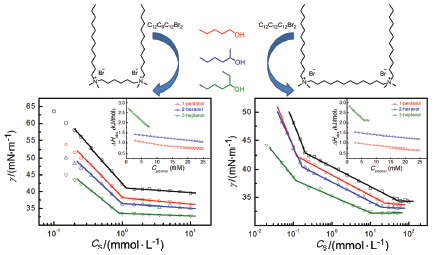| [1] Huang, J.B.; Mao, M.; Zhu, B.Y.Colloids Surf.A 1999, 155, 339.
[2] Han, F.; Huang, J.B.; Zheng, B.; Li, Z.C.Colloids Surf.A 2004, 242, 115.
[3] Zana, R.Adv.Colloid Interface Sci.1995, 57, 1.
[4] Herzfeld, S.H.; Corrin, M.L.; Harkins, W.D.J.Phys.Chem.1950, 54, 271.
[5] Almgren, M.; Swarup, S.J.Colloid Interface Sci.1983, 91, 256.
[6] Shinoda, K.J.Phys.Chem.1954, 58, 1136.
[7] Lawrence, A.S.C.; Pearson, J.T.Trans.Faraday Soc.1967, 63, 495.
[8] Singh, H.N.; Swarup, S.Bull.Chem.Soc.Jpn.1978, 51, 1534.
[9] Caponetti, E.; Martino, D.C.; Floriano, M.A.; Triolo, R.Langmuir 1997, 13, 3277.
[10] Attwood, D.; Mosquera, V.; Rodriguez, J.; Garcia, M.; Suarez, M.J.Colloid Polym.Sci.1994, 272, 584.
[11] Kabir-ud-Din; Kumar, S.; Kirti, Goyal, P.S.Langmuir 1996, 12, 1490.
[12] Sreejith, L.; Parathakkat, S.; Nair, S.M.; Kumar, S.; Varma, G.; Hassan, P.A.; Talmon, Y.J.Phys.Chem.B 2011, 115, 464.
[13] Dubey, N.J.Surf.Sci.Technol.2008, 24, 139.
[14] Zana, R.J.Colloid Interface Sci.1984, 101, 587.
[15] Zhang, X.R.; Huang, J.B.; Mao, M.; Tang, S.H.; Zhu, B.Y.Colloid Polym.Sci.2001, 279, 1245.
[16] Wang, C.Z.; Tang, S.H.; Huang, J.B.; Zhang, X.R.; Fu, H.L.Colloid Polym.Sci.2002, 280, 770.
[17] Tang, S.H.; Huang, J.B.; Dai, L.R.; Wang, C.Z.; Fu, H.L.Acta Chim.Sinica 2002, 60, 1.(唐世华, 黄建滨, 戴乐蓉, 王传忠, 付宏兰, 化学学报, 2002, 60, 1.)
[18] Huang, J.B.; Zhu, B.Y.; Zhao, G.X.; Zhang, Z.Y.Langmuir 1997, 13, 5759.
[19] Yin, H.Q.; Lei, S.; Zhu, S.B.; Huang, J.B.; Ye, J.P.Chem.Eur.J.2006, 12, 2825.
[20] Israelachvili, J.N.; Mitchell, D.J.; Ninham, B.W.J.Chem.Soc., Faraday Trans.2 1976, 72, 1525.
[21] Han, Y.C.; Wang, Y.L.Phys.Chem.Chem.Phys.2011, 13, 1939.
[22] Huang, X.; Han, Y.C.; Wang, Y.L.Acta Chim.Sinica 2013, 71, 897.(黄旭, 韩玉淳, 王毅琳, 化学学报, 2013, 71, 897.)
[23] Yang, F.; Li, G.; Liu, R.; Zhang, B.; Liu, Y.; Wang, Z.X.Acta Chim.Sinica 2009, 67, 723.(杨芳, 黎钢, 刘荣, 张彬, 刘洋, 王中旭, 化学学报, 2009, 67, 723.)
[24] Sun, Y.H.; Dong, H.W.; Feng, Y.J.; Chen, Z.Acta Chim.Sinica 2006, 64, 1925.(孙玉海, 董宏伟, 冯玉军, 陈志, 化学学报, 2006, 64, 1925.)
[25] Menger, F.M.; Littau, C.A.J.Am.Chem.Soc.1991, 113, 1451.
[26] Menger, F.M.; Keiper, J.S.Angew.Chem., Int.Ed.2000, 39, 1906.
[27] Zana, R.Adv.Colloid Interface Sci.2002, 97, 205.
[28] Hait, S.K.; Moulik, S.P.Curr.Sci.2002, 82, 1101.
[29] Song, L.D.; Rosen, M.J.Langmuir 1996, 12, 1149.
[30] Hu, S.L.; Lu, T.; Lan, Y.R.; Huang, J.B.Acta Phys.-Chim.Sin.2008, 24, 2309.(胡尚林, 卢婷, 兰玉茹, 黄建滨, 物理化学学报, 2008, 24, 2309.)
[31] Mohammad, R.; Khan, I.A.; Kabir-ud-Din; Schulz, P.C.J.Solution Chem.2013, 42, 2310.
[32] Khan, I.A.; Mohammad, R.; Alam, M.S.; Kabir-ud-Din.J.Disp.Sci.Technol.2010, 31, 129.
[33] Kabir-ud-Din; Siddiqui, U.S.; Ghosh, G.J.Disp.Sci.Technol.2009, 30, 1310.
[34] Kabir-ud-Din; Fatma, W.; Khatoon, S.; Khan, Z.A.; Naqvi, A.Z.J.Chem.Eng.Data 2008, 53, 2291.
[35] Kabir-ud-Din; Siddiqui, U.S.; Kumar, S.Colloids Surf.A 2007, 301, 209.
[36] Siddiqui, U.S.; Ghosh, G.; Kabir-ud-Din Langmuir 2006, 22, 9874.
[37] Zhu, Y.P.; Zhao, J.X.; You, Y.Acta Chim.Sinica 2002, 60, 1001.(朱永平, 赵剑曦, 游毅, 化学学报, 2002, 60, 1001.)
[38] Benrraou, M.; Zana, R.Tenside, Surfactants, Deterg.2005, 42, 175.
[39] Graciani, M.D.M.; Rodríguez, A.; Martín, V.I.; Moyá, M.L.J.Colloid Interface Sci.2010, 342, 382.
[40] Chen, L.F.; Li, Y.; Xie, H.Q.J.Disp.Sci.Technol.2008, 29, 1098.
[41] Wang, T.F.; Hu, J.; Peng, C.J.; Liu, H.L.J.Disp.Sci.Technol.2007, 28, 1169.
[42] Matsubara, H.; Eguchi, T.; Takumi, H.; Tsuchiya, K.; Takiue, T.; Aratono, M.J.Phys.Chem.B 2009, 113, 8847.
[43] Zana, R.J.Colloid Interface Sci.2002, 248, 203.
[44] Zana, R.J.Colloid Interface Sci.2002, 246, 182.
[45] Zhao, J.X.Acta Phys.-Chim.Sin.2010, 26, 2589.(赵剑曦, 物理化学学报, 2010, 26, 2589.)
[46] Nave, S.; Eastoe, J.; Penfold, J.Langmuir 2000, 16, 8733.
[47] Ezrahi, S.; Tuval, E.; Aserin, A.; Garti, N.J.Colloid Interface Sci.2005, 291, 263.
[48] Zhang, Q.; Tian, M.Z.; Han, Y.C.; Wu, C.X.; Li, Z.B.; Wang, Y.L.J.Colloid Interface Sci.2011, 362, 406.
[49] Evans, H.C.J.Chem.Soc.1956, 579.
[50] Biresaw, G.; McKenzie, D.C.; Bunton, C.A.; Nicoli, D.F.J.Phys.Chem.1985, 89, 5144.
[51] Ma, J.H.; Guo, C.; Tang, Y.L.; Zhang, H.; Liu, H.Z.J.Phys.Chem.B 2007, 111, 13371.
[52] Brand, T.; Cabrita, E.J.; Berger, S.Prog.Nucl.Magn.Reson.Spectrosc.2005, 46, 159.
[53] Shimizu, S.; Pires, P.A.R.; El Seoud, O.A.Langmuir 2003, 19, 9645.
[54] Zana, R.; Benrraou, M.; Rueff, R.Langmuir 1991, 7, 1072.
[55] Zana, R.; Xia, J.D.Gemini Surfactant: Synthesis, Interfacial and Solution-Phase Behavior, and Applications, CRC Press, 2003, 117, p.67. |
